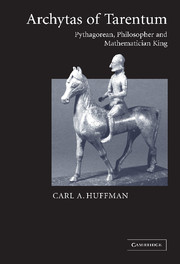Preface
Published online by Cambridge University Press: 04 August 2010
Summary
The last book devoted to Archytas was published over 160 years ago (Gruppe 1840). Even that work was not really a study of Archytas' thought but rather an unsuccessful attempt to argue that no authentic fragments of Archytas had survived from antiquity. It is not an exaggeration to say, then, that there has never been a book-length study of Archytas of Tarentum. There have not even been many shorter treatments. Erich Frank gave Archytas a fairly prominent role in his reconstruction of early Pythagoreanism (1923), but that reconstruction was eccentric and has been largely rejected by scholars. Essentially the only commentary has been that in Italian by Maria Timpanaro Cardini, as part of a three-volume commentary on all the Pythagoreans (1958–64). In recent years there have been a few important articles and sections of larger works dealing with isolated aspects of Archytas' work, notably his harmonic theory (e.g. Barker 1989, 1994; Bowen 1982; Cambiano 1998 and Lloyd 1990), but to say that Archytas has been neglected would be an understatement. Nonetheless, Archytas is one of the three most important figures in ancient Pythagoreanism (along with Pythagoras himself and Philolaus); we cannot hope to understand ancient Pythagoreanism without understanding Archytas. He was also an important philosopher, mathematician and political leader in his own right. Most scholarship on Greek philosophy during the first half of the fourth century has been devoted to Plato and the Academy.
- Type
- Chapter
- Information
- Archytas of TarentumPythagorean, Philosopher and Mathematician King, pp. xi - xviPublisher: Cambridge University PressPrint publication year: 2005

